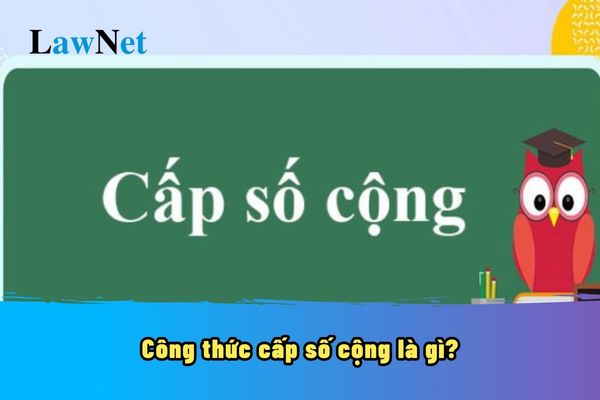What is the arithmetic sequence formula? What is the grade whose Mathematics curriculum covers arithmetic sequence in Vietnam?
What is the arithmetic sequence formula?
Students may refer to the following information on arithmetic sequence formula:
|
What is the arithmetic sequence formula? An arithmetic sequence is a list of numbers in which the difference between any two consecutive terms is constant. This constant difference is called the common difference, denoted as d. un = u1 + (n - 1)d Where: d = un+1 - un *Meaning of the quantities: |
*Note: Information is for reference only./.

What is the arithmetic sequence formula? What is the grade whose Mathematics curriculum covers arithmetic sequence in Vietnam? (Image from the Internet)
What is the grade whose Mathematics curriculum covers arithmetic sequence in Vietnam?
Under the General Education Program for Mathematics issued together with Circular 32/2018/TT-BGDDT:
*Sequences. Arithmetic Sequences. Geometric Sequences
- Sequences. Increasing and Decreasing Sequences:
+ Identify finite and infinite sequences.
+ Represent sequences by listing terms; by general formula; by recursive formula; by description.
+ Recognize the increasing, decreasing, and bounded properties of sequences in simple cases.
- Arithmetic Sequence. General Term of an Arithmetic Sequence. Sum of the first n terms of an Arithmetic Sequence:
+ Identify a sequence as an arithmetic sequence.
+ Explain the formula to determine the general term of an arithmetic sequence.
+ Calculate the sum of the first n terms of an arithmetic sequence.
+ Solve some practical problems associated with arithmetic sequences to solve real-life related mathematical problems (e.g., some issues in Biology, Population Education,...).
- Geometric Sequence. General Term of a Geometric Sequence. Sum of the first n terms of a Geometric Sequence:
+ Identify a sequence as a geometric sequence.
+ Explain the formula to determine the general term of a geometric sequence.
+ Calculate the sum of the first n terms of a geometric sequence.
+ Solve some practical problems associated with geometric sequences to solve real-life related mathematical problems (e.g., some issues in Biology, Population Education,...).
Therefore, the arithmetic sequence is included in the 11th-grade Mathematics curriculum.
What are the four perspectives on developing the 11th-grade Mathematics curriculum in Vietnam?
Under Section 2 of the General Education Program for Mathematics issued together with Circular 32/2018/TT-BGDDT, the perspectives on developing the 11th-grade Mathematics curriculum in Vietnam are as follows:
The Mathematics curriculum thoroughly implements the basic regulations outlined in the overall curriculum; inherits and promotes the strengths of the current curriculum and previous curricula, selectively absorbs experiences in designing subject curricula from advanced countries around the world, accesses achievements in educational science, and considers Vietnam's economic and social conditions. Additionally, the Mathematics curriculum emphasizes several viewpoints as follows:
[1] Ensuring simplification, practicality, modernity
The Mathematics curriculum ensures simplification, practicality, and modernity by reflecting essential contents that must be addressed in schools, satisfying the need for understanding the world, as well as the interests and preferences of learners, aligned with contemporary global approaches. The curriculum adheres to the spirit of "mathematics for everyone", where everyone can learn mathematics but each person can learn it in a manner suitable to their interests and abilities.
The Mathematics curriculum emphasizes applicability, connections to real-life or other educational disciplines and activities, especially those aimed at implementing STEM education, aligned with the modern developmental trends of the economy, science, social life, and urgent global issues (such as climate change, sustainable development, financial education, etc.). This is further reflected through practical and experiential activities in mathematics education by means such as conducting projects and study assignments related to mathematics, especially those concerning the application of mathematics in practice; organizing mathematics learning games, mathematics clubs, forums, seminars, mathematics competitions, etc., creating opportunities that help students apply their knowledge, skills, and experiences creatively in real-world contexts.
[2] Ensuring consistency, coherence, and continuous development
The Mathematics curriculum ensures consistency and continuous development (from Grade 1 to 12th-grade), comprising two closely linked branches: one describing the development of core knowledge strands and another describing the development of students' competencies and qualities. Furthermore, the curriculum pays attention to continuity with the preschool education program and provides a foundation for vocational and higher education.
[3] Ensuring integration and differentiation
The Mathematics curriculum implements intra-disciplinary integration revolving around three knowledge strands: Numbers, Algebra, and some elements of Analysis; Geometry and Measurement; Statistics and Probability; practices cross-disciplinary integration through related content, themes, or mathematical knowledge exploited and used in other subjects such as Physics, Chemistry, Biology, Geography, Informatics, Technology, History, Art,...; implements both intra-disciplinary and cross-disciplinary integration through practical and experiential activities in mathematics education.
Simultaneously, the Mathematics curriculum ensures differentiation. For all educational levels, the Mathematics discipline embraces the spirit of learner-centered teaching based on ensuring that the majority of students (across all regions of the country) meet the program's criteria; concurrently, it attends to specialized groups (talented students, students with disabilities, students with difficult circumstances, etc.). For the secondary education level, Mathematics has a system of specialized study topics and learning contents that aim to enhance students' knowledge and practical skills, applying problem-solving in real-world contexts.
[4] Ensuring openness
The Mathematics curriculum ensures unified direction and core, mandatory mathematics educational content for all students nationwide, while granting autonomy and responsibility to localities and schools in selecting and supplementing some mathematics educational content, and implementing educational plans that are suitable for the localities and schools' conditions.
The Mathematics curriculum only prescribes principles and general directions regarding the required achievements in students' qualities and competencies, educational content, educational methods, and assessment of educational outcomes, without overly detailed regulations, allowing textbook authors and teachers to exercise initiative and creativity in implementing the program.
The curriculum ensures stability and developmental capacity during implementation in accordance with scientific-technological advancements and practical demands.

